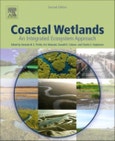Coastal Wetlands, Second Edition: An Integrated and Ecosystem Approach provides an understanding of the functioning of coastal ecosystems and the ecological services that they provide. As coastal wetlands are under a great deal of pressure from the dual forces of rising sea levels and the intervention of human populations, both along the estuary and in the river catchment, this book covers important issues, such as the destruction or degradation of wetlands from land reclamation and infrastructures, impacts from the discharge of pollutants, changes in river flows and sediment supplies, land clearing, and dam operations.
Please Note: This is an On Demand product, delivery may take up to 11 working days after payment has been received.
Table of Contents
1. Coastal Wetlands: A Synthesis2. The Morphology and Development of Coastal Wetlands in the Tropics
3. Temperate Coastal Wetlands: Morphology, Sediment Processes, and Plant Communities
4. Northern Polar Coastal Wetlands: Development, Structure and Land Use
5. Salt-Marsh Eco-Geomorphological Dynamics and Hydrodynamic Circulation
6. Geomorphology of Tidal Courses and Depressions
7. Methods to Estimate Heat Balance in Coastal Wetlands
8. Hydrodynamics and Modeling of Water Flow in Coastal Wetlands
9. Mathematical Modeling of Tidal Flow over Saltmarshes and Tidal Flats with Applications to the Venice Lagoon
10. Geomorphology and Sedimentology of Tidal Flats
11. Intertidal Flats: Form and Function
12. Biogeochemical Dynamics of Coastal Tidal Flats
13. Productivity and Biogeochemical Cycling in Seagrass Ecosystems
14. Tidal Salt marshes: Sedimentology and Geomorphology
15. Ecosystem Structure of Tidal Saline Marshes
16. Salt Marsh Biogeochemistry An Overview
17. The role of freshwater flows on salt marsh growth and development
18. Tidal Freshwater Wetlands
19. Biogeochemistry of Tidal Freshwater Wetlands
20. Biogeomorphology of mangroves
21. Biogeochemistry of mangroves
22. Ecogeomorphic Models of Nutrient Biogeochemistry for Mangrove Wetlands
23. Tidal Marsh Creation
24. Salt Marsh Restoration
25. Managed Realignment: Re-Creating Intertidal Habitats on Formerly Reclaimed Land
26. Methods and Criteria for Successful Mangrove Forest Rehabilitation
27. Evaluating Restored Tidal Freshwater Wetlands
28. The Shifting Salt Marsh-Mangrove Ecotone in Australasia and the Americas
29. The Value of Coastal Wetland Ecosystem Services
30. Blue Carbon
31. Towards a Salt Marsh Management Plan for New York City: Recommendations for Strategic Restoration and Protection
32. Living Shorelines for Coastal Resilience
33. Mangrove Management: Challenges and Guidelines








